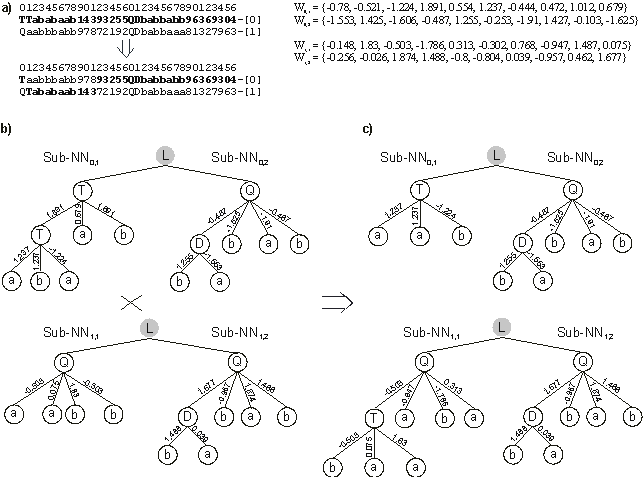Intragenic two-point recombination was created in order to allow the modification of a particular gene without interfering with the other sub-NNs encoded in other genes. The mechanism of this kind of
crossover is exactly the same as in two-point recombination, with the difference that the
crossover points are chosen within a particular gene
(see Figure 2).
Consider the following parent chromosomes composed of two genes, each with a weights' domain
(Wi,j represents the weights of gene j in chromosome
i):
W0,1 = {-0.78, -0.521, -1.224, 1.891, 0.554, 1.237, -0.444, 0.472, 1.012, 0.679}
W0,2 = {-1.553, 1.425, -1.606, -0.487, 1.255, -0.253, -1.91, 1.427, -0.103, -1.625}
0123456789012345601234567890123456
TTababaab14393255QDbabbabb96369304-[0]
Qaabbbabb97872192QDbabbaaa81327963-[1]
W1,1 = {-0.148, 1.83, -0.503, -1.786, 0.313, -0.302, 0.768, -0.947, 1.487, 0.075}
W1,2 = {-0.256, -0.026, 1.874, 1.488, -0.8, -0.804, 0.039, -0.957, 0.462, 1.677} |
Suppose that the first gene was chosen to recombine and point 1 (between positions 0 and 1) and point 12 (between positions 11 and 12) were chosen as recombination points. Then the following offspring is formed:
0123456789012345601234567890123456
Taabbbabb97893255QDbabbabb96369304-[0]
QTababaab14372192QDbabbaaa81327963-[1] |
with the weights encoded in exactly the same arrays as the parents. However, due to recombination, the weights expressed in the parents are different from those expressed in the offspring (compare their expressions in
Figure 2).

Figure 2. Intragenic two-point recombination in multigenic chromosomes encoding neural networks.
a) An event of intragenic two-point recombination between two parent chromosomes resulting in two new daughter chromosomes. Note that the set of weights is not modified by recombination.
b) The sub-NNs codified by the parent chromosomes. c) The sub-NNs codified by the daughter chromosomes. Note that the sub-NNs encoded in the second gene are not modified. “L” represents a generic linking function.
It is worth emphasizing that this gene-restricted two-point recombination allows a greater control of the recombination effects and, consequently, permits a finer tuning of evolution. If we were to use one-point and two-point recombination as used in the basic gene expression algorithm, i.e., disrupting chromosomes anywhere, the fine adjustment of the weights would be an almost impossible task. Restricting two-point recombination to only one gene, however, ensures that only this gene is modified and, consequently, the weights and thresholds of the remaining genes are kept in place.
Remember, however, that intragenic two-point recombination is not the only source of recombination in multigenic neural nets: gene recombination is fully operational in these systems and it can be combined with gene transposition to propel evolution further. And in
unigenic systems, the standard one-point and two-point recombination are also fully operational as only one gene is involved.
|
